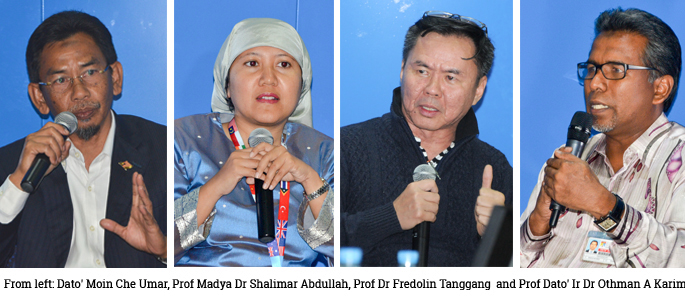Forum: Flood Relief Management Needs Improvement
 By Saiful Bahri Kamaruddin
By Saiful Bahri Kamaruddin
Pix Ikhwan Hashim
BANGI, 2 February 2015 – Lack of coordination and the chaotic way of distributing relief supplies had resulted in many households not receiving help during the recent devastating floods in Kelantan.
The 17th Bicara PERSADA forum of The National University of Malaysia (UKM) here on January 29 was told that the people who needed aid the most were poorly served despite many generous groups contributing to the relief efforts.
One of the speakers at the forum on ‘2014/2015 Floods: Unraveling the Chaos’, Dato’ Moin Che Umar, of UKM’s Institute for Environment and Development (LESTARI) admitted that the management of assistance could have been better blaming the lack of information for the shortcomings.
Dato’ Moin, who was a former Secretary of Crisis Management and Disaster of the National Security Council (MKN), however, denied that MKN was ill-prepared though acknowledging that there was a breakdown in law and order leading to widespread looting.
He criticised the media for not airing enough information on the emergency situation. “The public would not take seriously standard TV news reports on the floods. That is not enough. There should be periodical warnings and news flashes so that the people will realise how serious the situation is,” he said.
He proposed emergency exercises be carried out and warning sirens set up just like the Tsunami early-warning system enacted after the 2004 Indian Ocean tsunami.
Surgeon Prof Madya Dr Shalimar Abdullah an exco member of MERCY Malaysia, a non-governmental organisation (NGO) said the flood relief efforts was boged down with bureaucracy resulting in little actual assistance.
“Every time the MKN called for meetings, I have to write medical reports and when someone doesn’t attend, the MKN blamed us for not cooperating. Actually, I had a lot of work to do giving medical assistance in affected villages that recieved no aid at all. It’s like going in circles, with breakdowns in communications,” she lamented.
“Too many meetings, not enough work done, so I got fed up and went down to the field,” she said.
Dr Shalimar said the Orang Asli in the interiors of Kuala Krai Kelantan had suffered the most saying that one month after the massive floods and millions of ringgit spent towards relief and recovery efforts they were still unreachable.
“Feeling neglected and overlooked, some have started to complain why prompt assistance and aid were not provided to them, especially from the Orang Asli Development Department (Jakoa), which is supposed to help them cope with the situation,” she said.
An authority on Climatology and Oceanography, Prof Dr Fredolin Tangang of the Faculty of Science and Technology predicted that Malaysia will see more severe deluges like those that displaced more than 100,000 people in Kelantan recently due to a combination of global warming, deforestation and a lack of enforcement.
Prof Fredolin said since floods are a year-end phenomena, these factors could be present in other parts of the country which will make such disasters even more severe.
He explained that the extraordinary rainfall that Kelantan experienced in the span of three to four days, was due to a tropical climate element called the Madden-Julian oscillation (MJO) which originates from the Indian Ocean and passes through Malaysia four times a year.
When MJO comes in contact with the Northeast monsoon season that hits the peninsula at the end of 2014, it caused more than the usual rain, he said.
Prof Fredolin, who had just returned from Switzerland where he is vice-chairman of the Inter-Governmental Panel on Climate Change (IPCC), explained that the MJO increases the amount of easterly winds which carries more moisture and this leads to the monsoon dumping more rain than usual when it goes through the peninsula.
Unlike its well-known cousin El Niño, the MJO is both variable and unpredictable, earning the title of the largest and least understood element in the tropical atmosphere.
The fourth speaker UKM Students Civil Defence Corp Assistant Associate Commissioner, Prof Dato’ Ir Dr Othman A Karim proposed that a buffer zone be created in flood-prone areas, free from housing and human occupation.
He reasoned out that no amount of flood mitigation projects can help if people continue to live in areas that are easily inundated.
He said from his observation the devastation was greater in Kelantan than the 2006 floods in Johor where 200,000 people were evacuated but losses minimized because the relief efforts were more systematic then.
One of the country’s leading researchers on rainforests, Emeritus Professor Dato’ Dr Abdul Latif Mohamad who was in the audience disputed the common belief that deforestation and illegal logging were to blame during the question and answer session.
He said the worst floods in Kelantan in living memory actually occurred in 1926 and 1967, when there were little deforestation.
He believed that a cycle of 40 years – the so-called ‘Bah Merah’ because of the red clay-coloured water – is a factor.
Geographically, Kelantan is prone to floods due to the state’s low-lying areas in Kuala Krai, Machang, Pasir Mas and Kota Baru, which alone holds 80 per cent of water catchment areas in the State.
The forum was moderated by broadcaster Puspavathy Ramaloo.
![]()
